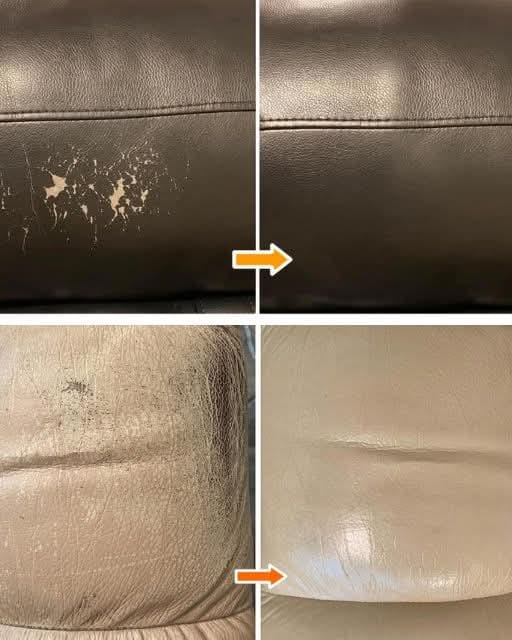ADVERTISEMENT
#### **What You’ll Need:**
– **Olive Oil or Coconut Oil**: Both oils are natural moisturizers that can penetrate and hydrate leather fibers, helping to restore moisture and flexibility to dry or cracked leather.
– **Vinegar**: A mixture of vinegar and water helps to clean and remove stains from the leather surface without damaging it.
– **Soft Cloth**: A microfiber or soft cotton cloth is perfect for applying oil and vinegar to your leather objects without causing scratches.
– **Leather Conditioner (optional)**: If you want to enhance the results, a leather conditioner can provide an additional layer of protection and restore the luster of your leather.
– **Shoe Polish or Leather Dye (optional)**: For deeper scuffs or discoloration, shoe polish or leather dye can help conceal and cover worn areas.
#### **Step-by-Step Guide to Repairing Leather at Home:**
##### **Step 1: Clean the Leather Surface**
Before you start repairing your leather, it’s essential to clean it. Dirt, dust, and oils from your hands can interfere with the repair process, so begin by wiping down the leather with a mixture of vinegar and water.
– Mix equal parts white vinegar and water in a small bowl.
– Dampen a soft cloth with the solution and gently wipe the leather surface.
– For more stubborn stains, gently rub the cloth on the affected area until it’s clean.
– Allow the leather to dry completely before moving on to the next step.
##### **Step 2: Moisturize with Olive or Coconut Oil**
Once the leather is clean and dry, it’s time to restore moisture. Olive oil or coconut oil is perfect for this because it helps to rehydrate the leather and bring back its flexibility.
– Pour a small amount of oil (about a teaspoon) onto a soft cloth.
– Rub the oil into the leather in small, circular motions, focusing on the worn-out, dry, or cracked areas.
– Allow the oil to absorb into the leather for about 10–15 minutes. The oil should soak in, making the leather feel soft and supple again.
##### **Step 3: Buff the Leather**
After applying the oil, you may notice that some areas are still a little too oily or greasy. This is where the buffing step comes in.
– Take a clean, dry soft cloth and gently buff the surface of the leather. This will help remove any excess oil and bring out a beautiful shine.
– Buffing also helps the leather regain its smooth texture and appearance.
##### **Step 4: Condition the Leather (Optional)**
If you want to add extra protection and restore the overall texture, you can apply a leather conditioner. Leather conditioners are designed to nourish and protect the material, ensuring it remains flexible and durable.
– Apply the leather conditioner according to the instructions on the packaging.
– Use a soft cloth to gently rub it into the leather in circular motions.
– Allow the conditioner to sit for a few minutes, then buff with a clean cloth to bring out the shine.
##### **Step 5: Repair Deeper Damage (Optional)**
For more serious scuffs, scratches, or faded areas, you can use leather dye or shoe polish to help restore the color and cover up the damage.
– Choose a dye or polish that matches the color of your leather item.
– Apply a small amount of dye or polish to a cloth and gently rub it into the damaged area.
– Let it dry completely, and then buff the area with a soft cloth to blend the color.
### **Additional Tips for Caring for Your Leather Items**
– **Regular Conditioning**: To keep your leather in top condition, apply oil or conditioner every 2–3 months, depending on how much you use the item.
– **Avoid Direct Sunlight**: Prolonged exposure to sunlight can cause leather to fade and dry out. Store leather items in a cool, dry place to avoid sun damage.
– **Protection from Water**: While leather is durable, water can damage it. Always wipe off any water immediately and let the leather air dry naturally (avoid using heat sources like hairdryers).
### **Conclusion**
With just a few household ingredients and a little time, you can repair worn leather objects and make them look as good as new. The simple trick of using **olive oil or coconut oil**, combined with **vinegar and water**, can restore moisture, flexibility, and shine to leather that’s seen better days. Whether it’s your favorite leather jacket, a pair of worn shoes, or a cherished leather bag, this effective home remedy will breathe new life into your leather items, saving you money and keeping them in top shape for years to come.
So, don’t toss those leather items just yet—give this home trick a try and watch them transform before your eyes!
